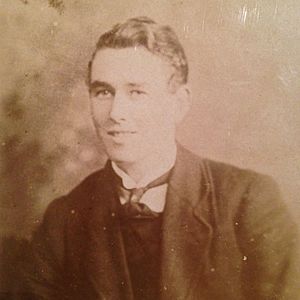Frank Potter (aviator) facts for kids
Quick facts for kids
Frank Potter
|
|
|---|---|
 |
|
| Born | 1891 Duleek, County Meath, Ireland |
| Died | 11 September 1917 (aged 25–26) |
| Buried |
Communal Cemetery Extension, Bailleul, Nord, France
(50°44′16″N 2°44′35″E / 50.73778°N 2.74306°E) |
| Allegiance | United Kingdom |
| Service/ |
British Army |
| Rank | Sergeant |
| Unit | No. 20 Squadron RFC |
| Battles/wars | World War I • Western Front |
| Awards | Military Medal |
Sergeant Frank Potter (1891 – 11 September 1917) was a brave British soldier during World War I. He was an air observer, which meant he flew in airplanes to spot enemy planes and help his pilot. Frank Potter became a special kind of hero called a flying ace because he helped shoot down seven enemy aircraft!
Contents
Frank Potter: A World War I Flying Ace
Frank Potter was born in 1891 in a place called Duleek, County Meath in Ireland. When World War I began, he joined the British Army. He became part of the Royal Flying Corps (RFC), which was the air force of the British Army at the time.
Joining the Fight in the Sky
In 1917, Frank Potter was serving in a group called No. 20 Squadron RFC. He flew in a type of airplane known as the Bristol F.2b. This plane was special because it had two seats: one for the pilot and one for the observer. The observer's job was to look for enemy planes and use a machine gun to defend their aircraft.
Becoming an Ace
Frank Potter achieved his first victory on June 16, 1917. He was flying with pilot Lieutenant N. V. Harrison. They managed to force an enemy plane, an Albatros D.III, down out of control near Ypres.
After this, Frank Potter gained six more victories between June 29 and July 28. All of these wins were against another type of enemy plane, the Albatros D.V. For these victories, he flew with a different pilot, Lieutenant Harold Joslyn. To be called a "flying ace," a pilot or observer usually needed to achieve five or more aerial victories. Frank Potter reached seven, making him a true hero of the skies.
His Final Flight
Sadly, Frank Potter was hurt on September 5, 1917. He had been wounded during a flight. He fought bravely, but he passed away from his injuries on September 11, 1917. He is buried in the Communal Cemetery Extension in Bailleul, Nord, France. His bravery and skill as an air observer are remembered as an important part of World War I history.

